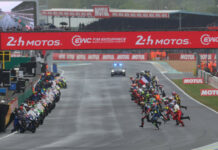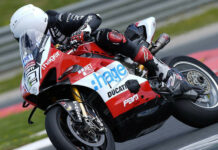Cypress, CA – December 15, 2017 –Yamaha’s latest additions to the Yard Built garage, an XS650 and XSR700 by custom builder Greg Hageman, reflect great respect and admiration for designs of the past paired with modern performance. Based out of Bettendorf, Iowa, Hageman modestly describes himself as “just a guy working in my garage,” but his latest projects have helped to established him as a premier builder with a true passion for creating beautifully simplistic bikes.
Shun Miyazawa, Motorcycle Project Manager for Yamaha Motor Corporation, USA, was quick to recognize Hageman’s abilities. “There are so many talented builders today, but Greg has shown his ability to innovate something new by working with the Yamaha Virago to the point where he established an entire category just for custom Virago builds.”
Yamaha’s Yard Built Project
Yamaha Sport Heritage motorcycles are designed & built with the “Faster Sons” philosophy: “Inspired by the past, built for the future.” Descended from the heritage of motorcycling’s past, today’s “Faster Sons” represent both the motorcycles and the riders who respect iconic Yamaha designs while continuing to push performance forward.
In this spirit, Yamaha also established an initiative to support custom bike-building globally. In garages and back yards all over the world, Yamaha owners dream of creating their very own customized motorcycles. Yamaha’s “Yard Built Project” seeks to enable these dreams by asking talented customizers to provide inspirational ideas on how to transform modern Yamaha models into “Yard Built” specials.
Many builders will not only inspire Yamaha owners with their ideas, but will also make custom parts and accessories available to help owners turn their dreams into reality.
“Fast Father” XS650
Hageman started working on Yamaha motorcycles back in the early 2000s. The first Yamaha he customized was a XS650 and he instantly fell in love with the simplicity. That first build kicked off Hageman’s love of vintage Yamahas and to date he has produced dozens of customs.
One such build is his “Fast Father” XS project bike, using a nearly mint 1972 XS2 as a platform. Hageman purchased the bike and set about resto-modding it with a focus on adding modern day performance. Step one was to send the engine off to MikesXS, a company that specializes in Yamaha XS engines, where they performed a full rebuild. They updated the engine using modern parts such as Mikuni VM34 carbs, a Pamco electronic ignition to replace the original points system, and an XSCharge permanent magnet alternator with a lithium battery to run updated LED lighting.
After receiving the engine back at his shop, Hageman updated the chassis with an early 2000-era R6 front end (to retain the conventional fork look) and paired it with a modified SR500 MotoLanna aluminum swingarm with Hagon rear shocks. Hageman retained the XS2 stock hubs, but laced up a pair of Excel rims with stainless spokes to run more modern Shinko 705 radials. After the basic structure of the bike was in place, Hagemen streamlined the look by finishing it off with a custom-made tuck-and-roll seat and a more modern Speedhut GPS-based speedometer.
“Homage to the past, performance of today”
When Greg Hageman saw that Yamaha was bringing the XSR700 to the U.S. market, he proposed a project idea to Yamaha’s Motorcycle Project Manager, Shun Miyazawa. His vision was to use his XS650 “Fast Father” as inspiration and build a “Faster Son” version using the XSR700.
Hageman admits the most challenging part of the build was sitting down and trying to decide which path to take. “When you build a custom bike, you can keep doing things and then think to yourself, ‘Am I improving this, or am I just making it different?’,” he said.
Yamaha’s Motorcycle Product Line Manager, Derek Brooks, was quick to reinforce that both Yamaha and Hageman have similar philosophies when it comes to blending the old and new. “One of the big points of the ‘Faster Sons’ philosophy isn’t so much that we want to make a modern retro bike. If we wanted to make a replica of an old bike, we could do that,” Brooks said. He then further explained the philosophy, stating “We want to offer all the modern technology and performance that people expect today with some flavor of the past. That’s where the XSR700 really hits the mark. We’re paying homage to the past with the performance of today.”
Hageman concurs with this philosophy, noting that “With this XSR project, you’re taking something that’s modern, new and fresh, and connecting it to its roots.”
Yamaha and Hageman both agreed that the XSR project needed to remain inspirational yet attainable—something the average rider could replicate in their own garage. “The XSR700 is very custom-friendly. It has all the numbers and the specs and everything to back it all up, but it also has good bones to build off,” said Hageman. “I could have taken this bike and done a full-blown custom and changed everything … but that wasn’t my idea. Instead, I wanted to simplify and streamline it, and build the bike as more of an inspiration for future buyers.”
“Faster Son” XSR700
The XSR, with its considerably more modern baseline, didn’t need much as far as performance upgrades. Therefore, Hageman focused on creating the atheistic synergy between the two bikes.
First, he added more retro-style fork gaiters and a 7-inch headlight bucket with a high-output LED headlight and integrated turn signals to match the styling of the XS2 headlight. While he was focused on the front end, Hageman also swapped out the factory handlebar risers for lower profile Yamaha Virago risers, and added a lower superbike-style bend handlebar from MikesXS. He then relocated the stock speedometer to a lower and more forward position, and streamlined and sculpted the front fender by removing material.
Turning his attention towards the rear of the bike, Hageman added Yamaha’s direct-fit solo seat and rear rack accessory. A custom tuck-and-roll seat was also added to match the XS2’s seat. As he did with the front fender, Hageman also modified and streamlined the rear fender. To give it that extra bit of retro feel, he powder coated the stock wheels in a silver color to match the XS2, and added a set of similarly-styled Shinko radial tires.
He originally considered lacing up a set of custom spoke wheels like the ones he used on his XS2, but Hageman ultimately decided he wanted to stay true to the main goal of keeping this bike attainable for the average builder. “For me, I didn’t want to add a set of $3,000 wheels to a $8,499 motorcycle,” noted Hageman. “It defeats the whole purpose of this build, which is to keep it aspirational yet attainable.”
When it comes to performance, though, Hageman did spend some money on an Akropovic exhaust system to liven-up power delivery and unleash the awesome sound of the XSR’s twin cylinder motor.
As far as the XSR platform and customization, Hageman is also a fan of the removable aluminum tank cover panels. “With the removable panels, it’s so easy to take them off and have your local painter come up with one paintjob, and then buy and paint another set of panels to create a whole other look,” he said. “The fact that the XSR comes with a bolt on subframe changes everything, too. It opens up the bike to so many more changes that the average person can do. You could take it off and just work with that alone or build your own subframe … or leave it off and work a fender off it, etc.”
The final step in tying the two bikes together was to use the same 1972 red paint that was on the XS2. Hageman’s regular sprayer, Moe Colors out of Tampa, Florida perfectly matched-up color on the removable XSR tank panels. A signature Hageman touch was adding some self-adhesive retro Yamaha badges to the XSR tank panels in yet another bid to make both bikes look more like “Father and Son.”
Son Meets Father
After seeing the final result of Hageman’s XSR700 project, and taking it for a spin, Shun Miyazawa expressed his admiration in detail. “First of all, it’s a very fun bike to ride,” said Miyazawa. “I like how he respected the original spirit of the XS650 and carried it over to this new platform. It’s not a copy and paste of the original design…he digested the core spirt of the XS650, understood it, and executed it in a slightly different way on the XSR700.”
Miyazawa further commented, “It’s much more modern but it still respects the original. It’s impressive how he made the perfect balance between the fun of riding performance and the roots of the XS650.”
As for Brooks, he is also a fan of the overall balance of the design. “It looks nimble and truly rideable,” he said. “I’ve seen thousands of custom bikes and some of them … when you look at them, you say, ‘That looks truly beautiful but I wouldn’t want to ride it … it looks uncomfortable or just un-rideable.’ When I look at this Hageman bike, it instantly makes me want to go ride it.”
Hageman also shared his thoughts on the final result, stating “Once you ride it, you’re hooked. It is so smooth and nimble. You feel that torque and power … it just wants to go!”
Miyazawa sums up the Hageman project rather simply by saying, “We’ve gone back to the basics of the Yard Built project with this XSR. Having worked with more than 40 custom builders who pushed out over 50 different custom bikes in last 6 years … this project was about getting back to the basics and taking inspiration from that.” Miyazawa added, “Making something special or making something look good doesn’t always require a lot of investment in time or money to accomplish that goal.”
Collaboration with Yamaha meant a lot for Greg Hageman, as demonstrated in the pride of craftsmanship with this build. “I’m very happy that Yamaha likes my work,” he said. “I’m just a little guy working in my garage, and for Yamaha to recognize and like what I do is a really big deal to me. I’m very proud that Yamaha allowed me to participate in this particular Yard Built project.”
To find out more about Greg Hageman’s XS650 and XSR700, visit:https://www.yamahamotorsports.com/sport-heritage/pages/yamaha-yard-built-xsr700-xs650-by-hageman
To learn more about the Yard Built Project, and see some of the custom motorcycles from builders around the world, visit: https://www.yamahamotorsports.com/sport-heritage/pages/yard-built-home
More information related to all Yamaha products can be found athttps://www.yamahamotorsports.com.
Follow Yamaha Motor Corp., USA at www.facebook.com/yamahamotorusa,www.twitter.com/yamahamotorusa and www.instagram.com/yamahamotorusa#Yamaha #YamahaMotor #YamahaMotorUSA
About Yamaha Motor Corporation, U.S.A. (YMUS)
Yamaha Motor Corporation, U.S.A. (YMUS), is a recognized leader in the powersports industry. The company’s ever-expanding product offerings include Motorcycles and Scooters, ATVs and Side-By-Side Vehicles, Snowmobiles, Outboard Motors, Personal Watercraft, Boats, Outdoor Power Equipment, Golf Cars, Race Kart Engines, Unmanned Helicopters, Accessories, Apparel, and much more. YMUS products are sold through a nationwide network of dealers in the United States.
Headquartered in California since 1960, YMUS also has facilities in Wisconsin and Georgia, as well as factory operations in Tennessee and Georgia. For more information about Yamaha, visitwww.YamahaMotorsports.com.






